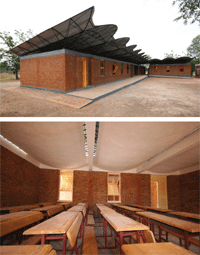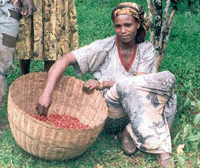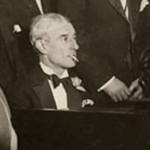
Letters and Comment
WIPO Magazine welcomes comments on issues raised in our articles or on other developments in intellectual property. Letters should be sent to The Editor at WipoMagazine@wipo.int or to the postal/fax address on the back cover of the Magazine. Please include your postal address. We regret that it is not possible to publish all the letters we receive. The editor reserves the right to edit or shorten letters. (The author will be consulted if substantial editing is required.)
Building sustainable change - Gando school re-visited

(Photos: Schulbausteine für Gando)
Three years ago WIPO Magazine wrote about our school building project in the village of Gando, Burkina Faso (Inspirational Creators – Diébédo Francis Kéré, Architect; issue no. 3/2005). Many people encountered the project for the first time through your report.
Today, more than 450 students are in attendance in the school and we are nearing completion of a new building with four classrooms on the school grounds. We are also building outside Gando. This photo shows the annex of a high school that my people recently completed on the behalf of an NGO about 600km from Gando using laterite stone, a commonly used building material in this region.
This is the first paid contract that has been carried out with a young workforce from Gando who have been trained as a part of program projects carried out by our Schulbausteine für Gando (School Bricks for Gando) association. The result has been met with feelings of great pride throughout all of Burkina Faso, not just by the members of Gando community.
It is with humility but also pride that the vision with which we began a few years ago has now begun to bear fruit. This project is proof that it is possible to introduce people in impoverished communities to new technologies and to instruct them in their application, thereby, empowering them to build better and more sustainable buildings.
I am adamantly convinced that through similar projects that prove of value to people’s everyday lives, we can bring about change in this region so often described as hopeless. I have learned with experience that one cannot bring about change by sitting at a desk at arm’s length from the problem. In cultures like mine that are marked by an educational crisis and where there is hardly any access to information, such objectives can only be achieved through example-setting projects brought about through the cooperation of people working for people. This is not the quickest nor the most convenient way; however, from the long-term perspective, it is the sustainable way.
For the near future, as well as meeting the very large demand for the replication of our models in other villages, we hope to build and equip a research center for construction engineering in my home village. This center would be the site where materials are studied and construction techniques can be investigated. At the same time, it would serve as a training center where young individuals would learn these techniques. In addition, special attention would be paid to the fostering international exchanges with technical experts and students. With the building of this facility, I would like to see the principles of climate-appropriate building anchored in my native region long-term.
I am indebted to WIPO Magazine and to everyone else who has placed value on and provided media coverage of my work.
_______________________
Creating the new brand identity for Ethiopia’s coffees…
Following your article last year on the Ethiopia and Starbucks story (Making the Origin Count: Two Coffees; issue no. 5/2007), readers may be interested to hear about the creation of the new Ethiopian Fine Coffees brand identity, which was unveiled at the meeting of stakeholders and licensed distributors on May 4. The Ethiopian Government appointed the Brandhouse agencyto develop a global identity which would represent and reflect their Fine Coffee varieties and elevate them to their rightful place amongst the world’s gourmet food and drinks.

(Courtesy Ethiopian IP Office)
Due to awareness of Ethiopian Fine Coffee being so low, both at trade/licensee level and with consumers, it was essential to create a simple, memorable, instantly recognizable global brand that said ‘Ethiopia’ loud and clear, and that reflected the premium values and diversity of the various individual varieties. Brandhouse was also keen to reflect the vibrancy and energy of the country, capturing the rich and lively colors for the sub brands of Yirgacheffe, Harar and Sidamo. With such diverse history and peoples, it was also important to be culturally sensitive in creating an identity that those employed in the industry could be proud of.
The heart of the brand identity is a stylized coffee-bean shaped like the letter ‘E’ (or a stylised letter ‘E’ shaped like a coffee-bean) which powerfully links the nation with the product. The symbol will be seen by many different audiences globally, and will have many different ‘usages,’ so it was imperative that it was all-encompassing and easy to replicate - whether on licensed distributors’ retail packs, or as a simple stencil on a Sidamo coffee sack.
_______________________
… While coffee farmers begin reaping the fruits of IP

(Courtesy USAid)
Although it is too early to draw definitive conclusions, there are signs that the trademark and licensing strategy which we have been pursuing in our country is already helping to improve the lives of the 15 million Ethiopians who depend on the coffee sector. The initiative, and the high profile case with Starbucks, contributed to an increased awareness of Ethiopian fine coffees and an improved bargaining position. It provided a framework for joint promotion that meets the needs of the actors in the coffee trading chain and of consumers. Although an impact assessment has not been made, and a number of factors may have contributed to the rise in the present price of the fine coffees, the steps taken by the government and farmers to enhance quality, together with the partnership framework and improved marketing position established as a result of the initiative, are expected to sustain the price increase in the coming years.
The initiative aims to capture the intangible values incorporated in our three fine coffees and increase the share that goes back to the coffee growers. It also reverses the disastrous trend of farmers’ cutting down heritage coffee trees, such as Harar, to plant the narcotic khat.
In many developing countries, people perceive intellectual property as being mostly in the interest of America, Europe and Japan. This is a misperception. Intellectual property, if properly used, can meet the needs of countries like Ethiopia. I personally believe that every country, whether poor or rich, has the capacity to create intellectual property assets.
_______________________
Compulsory licensing is no cure for poor countries
At the World Health Assembly meeting this week we will no doubt hear again vocal activists repeating the misplaced view that patents prevent the poor from accessing essential medicines. Yet a 2004 study published in the Journal of Health Affairs showed that less than two percent of prescription drugs on the WHO's Model List of Essential Medicines are under patent.
Patents are not to blame for appalling public health conditions in much of Africa. What use would it be to patients to receive even free medication, if they are only to continue drinking from polluted rivers, or being exposed to respiratory infections from traditional heating systems of animal dung and firewood or sharing their beds with malarial mosquitoes from open sewers?
It is not patent laws that prevent equal access to healthcare for pregnant women who rely on birth attendants working with defunct medical equipment and whose new born babies lie bare on hard floors.
Add together inadequate insurance, unaccountable administrators, abusive import tariffs on medicines, counterfeit drugs, poor roads, insufficient medical staff, dilapidated health centers and corruption, and you have the real health environment that many activists fail to acknowledge.
Yet many a developing country has fallen in love with the compulsory licensing of patented drugs, while at the same time urging private investments in R&D to develop new medicines for the diseases of poverty. But how can shareholders be convinced to invest in R&D if the resulting inventions are likely to be met with prejudiced ideology instead of sensible economics?!
Breaking drug patents and stifling the creation of life-saving medicines is not the way for poor countries to improve medical care. Our governments need to be helped to adopt prudent economic policies which have the greatest potential for building sound health infrastructure and buying health insurance for the poor.
_______________________
P2P – A parasitic business model
World Intellectual Property Day came and went with a global focus on the need to protect IP. I found it ironic, therefore, that a recent book I co-authored had been illegally uploaded to the Torrent Network on the eve of World Intellectual Property Day and was now available on peer-to-peer (P2P) networks. It was doubly ironic as the book was written to guide businesses leaders, security professionals and others in how to preserve their intellectual property.
Should I be flattered, I smiled? How often does the title of a book – Secrets Stolen, Fortunes Lost – become reality? But P2P networks exist so individuals can illegally download the creative works of others without paying. Or to put it in the “me” context, to steal the creativity and thoughts expressed in my book. So as the smile fades and the reality sets in, my mood changes– “Arghh!”
Let us shine light on this parasitic business model. A search of the book’s title accompanied by the keyword “torrent” resulted in no less than 110 separate pointers on Google – it's nice to be popular! The entry points call themselves libraries of the future, free e-books distributors, etc. But how is this illicit “business” activity monetized?
The “legal” revenue stream arrives via advertising. The user registration at the site required to get to the download location is designed to give the site owner a confirmed auditable site member/user/reader to present to advertisers. These registered users are a potential revenue stream from direct site advertisers. Additionally, contextual ads from Google, Yahoo, MSN and others, provide a cash stream generated by every click-through from their website – thus creating a second, albeit small, ka-ching in the virtual cash register.
The “illegal” revenue stream begins with the confirmed e-mail address being sold to malware miscreants. The file provides to the unsuspecting user additional crimeware – at no extra charge! - designed to separate the personal identifying data from the user. In addition, as you close the browser windows, you may suffer involuntary redirects to the low-end of the Internet population, the smut sites.
Sometimes life is amusing when you detach yourself from reality, but sobers up when you understand what is really going on. Now let's figure out how to get the toothpaste back in the tube.
_______________________
Fakes cost more

Lethal attraction (Photo: myauthentics.com)
I write to inform your readers of the great strides The Authentics Foundation has made this year in raising awareness of the ill effects of fakes. The foundation is an international nonprofit organization which, through both grassroots programs and the Internet, informs consumers about how to spot fakes and why purchasing counterfeits is detrimental to our economy and our world. On March 10, we hosted the Fakes Cost More summit in Brussels, Belgium. The summit, opened by the European Commission President, Jose Manuel Barosso, and attended by model Yasmin LeBon and actress Alice Taglioni, was heralded by the international press, and the message—Fakes Cost More—reached consumers as near as neighboring EU countries and as far as the Middle East and China.
In this era, everything known to mankind is being faked, and nowhere was this more in evidence than at the exhibit of counterfeits on display at the Fakes Cost More summit, together with explanations of how each fake was either a health or social hazard. Everything from shoddy brake pads or dangerous batteries to lethal medication was exhibited. A counterfeit P4 Ferrari - of which only four original models were ever produced - received enormous media attention, coming just one week after a counterfeit Ferrari ring was busted in Italy. The message that counterfeit auto parts can and do backfire was not lost on a concerned public.
The myauthentics.com website provides practical information that consumers can use to make smart, safe purchases. It has been visited by tens of thousands of web users this year and was recently featured in the eBay Against Counterfeits campaign as a go-to site for a deeper look at counterfeiting. The Foundation’s message is reaching more and more of the public through innovative programs such as university-based presentations, social networking sites and beyond. The Authentics Foundation believes that once consumers are afforded information about the deeper implications of purchasing fake goods, they never purchase fakes again.
_______________________
Ravel’s works not yet in the public domain

While congratulating you on the quality of the WIPO Magazine, I was astonished to see in the article Welcome to the Public Domain (Issue no. 1/2008) that the author had included Maurice Ravel among those whose works entered the public domain at the end of 2007. In fact, two French laws extended the period of copyright protection to take account of the two World Wars. And in the particular case of the works of musicians – which (unlike written works) were already protected in France for 70 years after the death of the composer even before the 1993 European Directive harmonized copyright duration – these extensions are still in force.
Interested readers may like to refer to a short article that I happened to write on this subject for the Bulletin des bibliothèques de France blog, “Copyright Duration and Music: Oh What a Lovely War!”
_______________________
The WIPO Magazine is intended to help broaden public understanding of intellectual property and of WIPO’s work, and is not an official document of WIPO. The designations employed and the presentation of material throughout this publication do not imply the expression of any opinion whatsoever on the part of WIPO concerning the legal status of any country, territory or area or of its authorities, or concerning the delimitation of its frontiers or boundaries. This publication is not intended to reflect the views of the Member States or the WIPO Secretariat. The mention of specific companies or products of manufacturers does not imply that they are endorsed or recommended by WIPO in preference to others of a similar nature that are not mentioned.